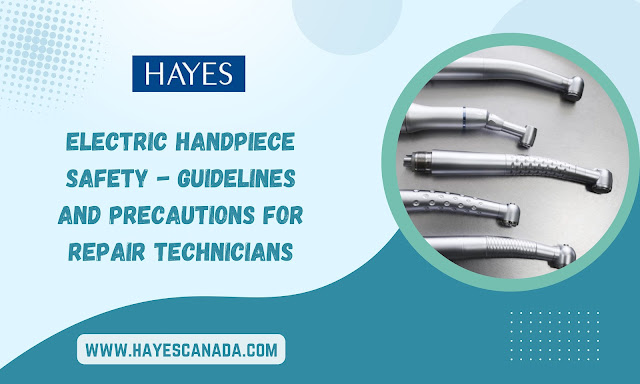Electric Handpiece Safety - Guidelines and Precautions for Repair Technicians
Electric handpieces are vital tools used in various fields such as dentistry, and surgery. When it comes to electric handpiece repairs, it is crucial for technicians to prioritize safety. Repairing these complex devices requires expertise, attention to detail, and adherence to safety guidelines to prevent accidents and ensure optimal performance. Here are some essential guidelines and precautions that repair technicians should follow when working on electric handpieces.
Familiarize Yourself with the Manufacturer's Instructions
Before attempting any repairs, it is crucial to carefully
read and understand the manufacturer's instructions for the specific electric
handpiece model. These instructions provide valuable insights into the device's
construction, recommended repair procedures, and safety precautions.
Familiarizing yourself with this information will ensure that you follow the
correct repair protocols and avoid any potential risks.
Power Off and Disconnect
Always ensure that the electric handpiece is powered off and
disconnected from any power source before starting the repair process. This
precautionary measure will minimize the risk of electric shocks or accidental
activation of the device during repairs.
Use Personal Protective Equipment (PPE)
When working on electric handpieces, wear appropriate
personal protective equipment (PPE) to safeguard yourself from potential
hazards. This may include safety glasses, gloves, face masks, and protective
clothing. PPE acts as a barrier against debris, chemicals, or other harmful
substances that may be encountered during the repair process.
Proper Tool Usage and Handling
Use the correct tools and equipment for electric handpiece
repairs and ensure that they are in good working condition. Inspect tools
regularly for signs of damage or wear and replace them as needed. Improper tool
usage or using damaged tools can lead to accidents or damage to the handpiece.
Avoid Forceful or Excessive Pressure
When disassembling or reassembling electric handpieces,
avoid applying excessive force or pressure. Excessive force can cause damage to
delicate components or compromise the integrity of the handpiece. Follow the
manufacturer's guidelines for disassembly and reassembly carefully to ensure
proper handling.
Proper Disposal of Waste Materials
Dispose of waste materials, such as used components,
lubricants, or cleaning solvents, in accordance with local regulations.
Improper disposal can harm the environment and pose a risk to human health.
Follow proper waste management practices to ensure the safe and responsible
disposal of all waste generated during the repair process.
Conclusion
Electric handpiece repairs require careful attention to
safety guidelines and precautions to protect both the technician and the
equipment being repaired. By following these guidelines, repair technicians can
minimize the risk of accidents, ensure optimal performance, and maintain a safe
working environment. Prioritizing safety during electric handpiece repairs
promotes professionalism, efficiency, and reliability in the field of repair
and maintenance.




Comments
Post a Comment